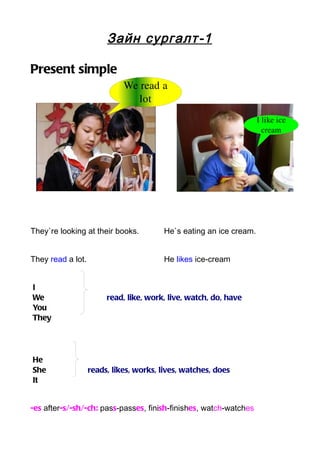Altanginj zain sutgalt
- 1. ąŚą░ą╣ąĮ čüčāčĆą│ą░ą╗čé -1 Present simple We┬Āread┬Āa┬Ā lot I┬Ālike┬Āice┬Ā cream They`re looking at their books. He`s eating an ice cream. They read a lot. He likes ice-cream I We read, like, work, live, watch, do, have You They He She reads, likes, works, lives, watches, does It -es after-s/-sh/-ch: pass-passes, finish-finishes, watch-watches
- 2. -y-ies: study-studies try-tries also: do-does go-goes exercises 1.Write these verbs: -s or -es ( read ) she......... ( think ) he........ ( fly ) it........... ( dance ) he......... ( have ) she...... ( finish ) it........ 2.Complete the sentences about the people in the picture. Use these verbs: eat, go, live, play, play, sleep
- 3. We..... a lot of fruit We.....to the cinema a lot. She.... the piano. They..... in a very big house.
- 4. I....... tennis. I.......8 hours a night.
- 5. ąŚą░ą╣ąĮ čüčāčĆą│ą░ą╗čé -2 Regular and irregular verbs Regular verbs The past simple of regular verbs is-ed: clean-cleaned live-lived paint-painted study-studied Irregular verbs The past simple of irregular verbs are not - ed:
- 6. Exercise Match the following words
- 13. Ex er ci se s Put in / on / at 1. Don`t sit.....the grass. it`s wet. 2. What have you got.....in your bag? 3. There are few shops.....the end of the street. Look at the picture and answer the questions. Where is.........cat.













